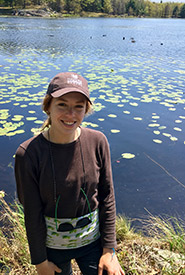It’s turtle time!
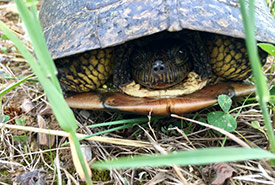
Blanding's turtle (Photo by NCC)
Anyone who drives the winding, hilly roads of Ontario’s Frontenac Arch is familiar with the picturesque views of forest rolling along granite ridges, lakes scattered across the landscape, diverse wetlands and the potential for wildlife sightings without even leaving your vehicle.
On my daily drive to work, I often encounter white-tailed deer grazing in the open fields or along the shoulder of the road, great blue herons flying above or standing majestically on a fallen tree in a wetland, chipmunks scurrying back and forth, red fox kits pouncing through the grass, and, lately, a lot of turtles!
Many people compare slow things to turtles. We know that turtles move slowly, but you may not know that turtle development is also slow. It can take 15 to 20 years for a turtle to reach reproductive maturity! Since the breeding age of turtles is so high, the survival of older, mature individuals is important to ensuring the overall success of the populations.
Once turtles reach adulthood, they generally have very few natural predators because adult turtles' shells are more developed, making them tougher to eat when they retract into their shells, even for predators like coyotes. Despite this lack of natural predators, you may ask why all eight of Ontario's native turtles are now designated as species at risk. Unfortunately, due to habitat loss and fragmentation, mature adults, which sometimes travel kilometres to reach traditional nesting sites, are now forced to cross roads on the way to their destination. So, as the weather warms up, both vehicle and turtle traffic on our roads increase and so does the threat of road mortality to our native turtle populations.
Related blog posts
The Nature Conservancy of Canada’s (NCC’s) eastern Ontario stewardship team has made helping turtles safely cross the road part of our day-to-day mission on the drive from our office at the Queen’s University Biological Station to our field sites. During this field season alone, we have helped around 30 turtles safely cross the road!
Back in June of 2019, I was driving to the Fishing Lake Creek property with conservation technicians Allison Sawyer and Nick Fritzsche to control invasive garlic mustard, when we spotted a painted turtle heading toward the shoulder of the road. It was probably coming from a nearby wetland on the other side of the road. We found a safe spot to turn the car around and help our little friend. But in the meantime, a long line of cars passed in the other direction, and I thought, “Please, please be okay little turtle!” We pulled over and got out of the car to discover that the turtle had been struck and was in distress.
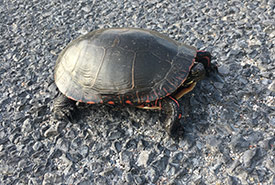
Painted turtle (Photo by NCC)
I have encountered turtles in a similar state before, so we quickly made a plan to fulfill our mission in helping this turtle. The crew moved the turtle to the shoulder of the road. We then called the Ontario Turtle Conservation Centre in Peterborough for advice on the next steps. They advised us that their partners at the Perth Veterinary Clinic admitted injured turtles. Within 10 minutes, the plan for the rest of the day had changed, and we were on our way to Perth!
It was a little strange sitting in the waiting room of the vet clinic with a turtle in a bucket, surrounded by everyone else with their dogs and cats. By taking it to a vet, we know that we gave it the best possible chance.
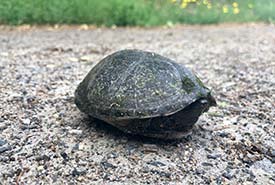
Musk turtle (Photo by NCC)
Fast forward to June 2021, I am stopping quite often to help turtles safely cross the road. I’ve probably helped 10 so far. I helped a musk turtle (stinkpot) safely cross Perth Road (the same road the painted turtle was injured on two years ago)!
What to do if you encounter a turtle on the road
- Safety first! Make sure you and your vehicle are out of the way of danger before approaching the turtle.
- Move the turtle to the shoulder of the road, in the direction it was heading. Not sure how? Watch this NCC video on how to help turtles cross the road.
Injured turtles
- If possible, pick up the turtle and move it off the road (as shown in the video mentioned above) to avoid further injury.
- Call the Ontario Turtle Conservation Centre at 705-741-5000 for advice on what to do next. If you’re calling after hours, leave them a message and they will get back to you when they open. If you have to keep a turtle overnight, place it in a well-ventilated container with no water in a cool, dark place, away from pets.
- Place the turtle in a container with no food or water. This could be a box, old cooler, recycling bin, bucket or whatever container you have handy to transport it. Make sure to make breathing holes if there is a lid on the container!
- Make note of the closest intersection or record a GPS location of where the turtle was found.
- Wash your hands after handling the turtle.
- Report your sighting to iNaturalist and add it to the Ontario Reptile and Amphibian Atlas project in iNaturalist to help track turtle populations across Ontario.
Turtle trooper kit
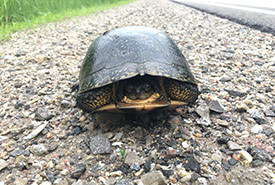
Blanding's turtle (Photo by NCC)
Keep these simple supplies handy in your vehicle to prepare for your next turtle encounter:
- small, clean recycling bin
- gloves
- hand sanitizer
- pen and notebook
Remember, while it is important to assist turtles across roads, never relocate them. This can cause great stress, as they will attempt to make their way back to where you found them.
Turtles in Ontario need our help. Do your part and give them a brake!

